Legendary And Mysterious Stone Of Brutus – The London Stone Refuses To Give Up Its Secrets
Ellen Lloyd - AncientPages.com - Why the mysterious Stone Of Brutus was brought to London, UK, remains unknown.
Several theories attempt to explain Stone's enigmatic past, but even to this day, this mysterious Stone refuses to give up its secrets.
The London Stone. Credit: Lonpicman - CC BY-SA 3.0
It is possibly more than 3,000 years old and may be Druidic in origin, but it is more likely of Roman origin.
At first glance, it looks like an ordinary rock wedged in a wall. However, this old Stone is far from common.
The legendary London Stone, also known as the Stone of Brutus (after referring to the mythical Trojan founder of London), has been a symbol of the City for at least 900 years.
According to an ancient legend, Brutus the Trojan, or Brutus of Troy, founded London around 1070 BC, about 1,000 years before the Roman invasion.
The Stone behind its 1869 grille: an engraving by Gustave Doré, 1872. Public Domain
Following the destruction of the City of Troy, the inhabitants set off to find new lands. Brutus, a Trojan prince, is said to have been guided to the triangular white island of Albion by the goddess Diana.
After sailing up the Thames, he first had to fight a race of giants led by Gog and Magog. The City he established was called 'Troia Newydd' (New Troy), which later became 'Trinovantum.' The people who came with him were 'Britons.' Brutus put his palace on the site where the Guildhall is today and a temple in honor of Diana, the goddess who had guided him, on the hill site where St Paul's is.
It has been suggested that the Stone of Brutus is the altarpiece of this temple. Brutus is supposed to have been buried at the other sacred hill site, now known as Tower Hill, and there are statues of Gog and Magog at the Guildhall.
London Stone in its 1820s casing. W.H. Prior - Mechanical Curator collection. Credit: Public Domain
"The Historia Regum Britanniae relates that Albion was only inhabited 'by a few giants' when Brutus and his fellow Trojans arrived. Corineus was 'given Cornwall to govern, where there were more giants than in any other province. Among these giants 'was one detestable monster named Goëmagot (Gogmagog), in stature twelve cubits and of such prodigious strength that at one shake, he pulled up an oak as if it had been a hazel wand.'
When Brutus is holding a feast with his companions in Totnes (or more likely Dartmouth, which is much nearer the sea), some twenty giants led by Goëmagot descend on the company 'among whom he made a dreadful slaughter. At last, the giants were routed and slain, except for Goëmagot.
The latter was captured so that Corineus could wrestle with him. The giant broke three of Corineus's ribs, which so enrages him that he 'ran with him, as fast as the weight would allow him, to the next shore' and 'getting upon the top of a high rock, hurled down the savage monster into the sea; where falling on the sides of craggy rocks, he was torn to pieces. The place where he fell 'is called Lam Goëmagot, that is, Goëmagot's Leap, to this day.'"
Some think there is a connection between the Stone of Brutus and the legendary King Arthur. King Arthur by Charles Ernest Butler (1864-1933). Credit: Public Domain
In folklore, Gogmagog was a mighty giant of the few remaining on the island known today as Britain. Brutus of Troy landed at Totnes on the Dart River to discover fertile land and decided the country should be his own. Britain is named after Brutus, according to legend.
The Stone of Brutus is a block of limestone not naturally found in or around London. Geologists have concluded that the nearest source for its origin would be in Kent, 60 miles away. Who brought the Stone of Brutus to London and why?
The earliest written reference to the London Stone is in a book belonging to King Athelstan in the early 10th century. It was a familiar transportation landmark in the 12th century when it was referred to as the Londenstane.
Moving the Stone is associated with an ancient spell of doom. An ancient warning comes with the limestone block that says:
'So long as the Stone of Brutus is safe, so long will London flourish.'
The truth is that the London Stone has been moved several times, but it always seems to have been in the same stretch of Cannon Street opposite St Swithin's church. Once, it had its location in the middle of the street. In 1742, it was moved to the north side of the church and has been there ever since.
Many scholars have attempted to reveal the truth behind the myths and legends associated with the Stone of Brutus.
In 1598 the London historian John Stow admitted that "The cause why this stone was set there, the time when, or other memory hereof, is none." William Camden, another English historian, was of a different opinion. He suggested that the Stone of Brutus was a central stone from which all distances in Roman Britain were measured and similar to the Milliarium Aureum of Rome. Although his theory became popular, there is no evidence supporting this claim.
Other interesting stories include the Stone being the remains of an ancient stone circle that once stood on nearby Ludgate Hill. In other legends, the Stone had associations with the legendary King Arthur. Dr. John Dee (1527 - 1608), occultist and adviser to Queen Elizabeth I, was fascinated by the powers of the London Stone that he decided to live close to it for a while. In the 18th century, several writers speculated that the Stone was prehistoric and had been an object of Druidic worship.
Some researchers have suggested the Stone is located along a ley line connecting significant places.
The true origin and purpose of the Stone of Brutus remain shrouded in mystery until this very day.
Written by - Ellen Lloyd – AncientPages.com
Updated on October 16, 2022
Copyright © AncientPages.com All rights reserved. This material may not be published, broadcast, rewritten or redistributed in whole or part without the express written permission of AncientPages.com
More From Ancient Pages
-
 85 Beautiful And Rare Coptic Textiles – A Gift To Museum At Queens College
Archaeology | Apr 4, 2017
85 Beautiful And Rare Coptic Textiles – A Gift To Museum At Queens College
Archaeology | Apr 4, 2017 -
 Just 7% Of Our DNA Is Unique To Modern Humans – We Are Not Much Different From The Neanderthals
Archaeology | Jul 27, 2021
Just 7% Of Our DNA Is Unique To Modern Humans – We Are Not Much Different From The Neanderthals
Archaeology | Jul 27, 2021 -
 Unique Purbeck Marble Found On England’s Oldest Historic Shipwreck
Archaeology | Jun 14, 2024
Unique Purbeck Marble Found On England’s Oldest Historic Shipwreck
Archaeology | Jun 14, 2024 -
 Medicine in Antiquity: From Ancient Temples To Roman Logistics
Archaeology | Apr 13, 2018
Medicine in Antiquity: From Ancient Temples To Roman Logistics
Archaeology | Apr 13, 2018 -
 220 Million-Year-Old Dinosaur Footprint Found On Wales Beach By Girl
Fossils | Feb 1, 2021
220 Million-Year-Old Dinosaur Footprint Found On Wales Beach By Girl
Fossils | Feb 1, 2021 -
 Four Rare And Incredibly Well-Preserved 1,900-Year-Old Roman Swords Found In Judean Desert
Archaeology | Sep 6, 2023
Four Rare And Incredibly Well-Preserved 1,900-Year-Old Roman Swords Found In Judean Desert
Archaeology | Sep 6, 2023 -
 A 2,700-Year-Old Urartians’ Ayanis Castle And Haldi Temple – Soon An Open-Air Museum
Archaeology | Aug 10, 2020
A 2,700-Year-Old Urartians’ Ayanis Castle And Haldi Temple – Soon An Open-Air Museum
Archaeology | Aug 10, 2020 -
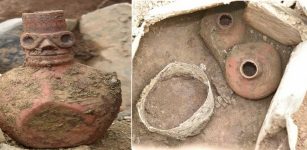 Wari Culture: Ancient Astronomical Observatory Excavated In Cusco, Peru
Archaeology | Dec 20, 2017
Wari Culture: Ancient Astronomical Observatory Excavated In Cusco, Peru
Archaeology | Dec 20, 2017 -
 10 Spooky Ancient Places That Are Home To The Feared Living Dead
Featured Stories | Oct 31, 2020
10 Spooky Ancient Places That Are Home To The Feared Living Dead
Featured Stories | Oct 31, 2020 -
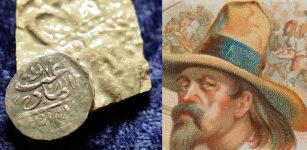 Can This Ancient Coin Solve The Mysterious Disappearance Of Pirate Henry Every?
Archaeology | Apr 1, 2021
Can This Ancient Coin Solve The Mysterious Disappearance Of Pirate Henry Every?
Archaeology | Apr 1, 2021 -
 Unique Temple Of The Condor In Machu Picchu: 3D Spectacular Inca Stonemasonry
Civilizations | Sep 21, 2016
Unique Temple Of The Condor In Machu Picchu: 3D Spectacular Inca Stonemasonry
Civilizations | Sep 21, 2016 -
 Beowulf Is Much Older Than Previously Thought And Not An English Poem – Professor Says
Linguistic Discoveries | Jan 6, 2020
Beowulf Is Much Older Than Previously Thought And Not An English Poem – Professor Says
Linguistic Discoveries | Jan 6, 2020 -
 Secrets Of Mysterious Bronze Age Hoard Found In Rosemarkie, Scotland Revealed
Archaeology | Jul 31, 2024
Secrets Of Mysterious Bronze Age Hoard Found In Rosemarkie, Scotland Revealed
Archaeology | Jul 31, 2024 -
 One Of The Biggest Gold Treasures Ever Discovered In Denmark Is 1,500-Year-Old
Archaeology | Sep 6, 2021
One Of The Biggest Gold Treasures Ever Discovered In Denmark Is 1,500-Year-Old
Archaeology | Sep 6, 2021 -
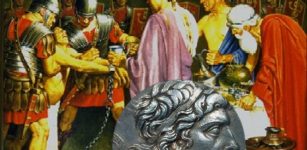 King Mithradates VI Of Pontus Used Poison To Avoid Death By Poison
Ancient History Facts | Mar 5, 2016
King Mithradates VI Of Pontus Used Poison To Avoid Death By Poison
Ancient History Facts | Mar 5, 2016 -
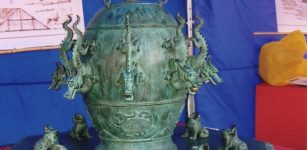 Zhang Heng Seismograph Could Record Earth’s Dangerous Movements
Artifacts | Mar 8, 2023
Zhang Heng Seismograph Could Record Earth’s Dangerous Movements
Artifacts | Mar 8, 2023 -
 How Climate Change Contruibuted To The Transition From Nomadic Hunter-Gatherers To Settlement And Farming Societies
Archaeology | Nov 27, 2021
How Climate Change Contruibuted To The Transition From Nomadic Hunter-Gatherers To Settlement And Farming Societies
Archaeology | Nov 27, 2021 -
 Nevsehir Labyrinth Of Tunnels: Largest And Most Complex Underground City In The World
Civilizations | Apr 7, 2015
Nevsehir Labyrinth Of Tunnels: Largest And Most Complex Underground City In The World
Civilizations | Apr 7, 2015 -
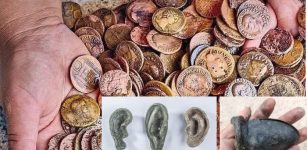 Extraordinary Etruscan And Roman Treasure Trove Unearthed In San Casciano dei Bagni, Italy
Archaeology | Aug 12, 2022
Extraordinary Etruscan And Roman Treasure Trove Unearthed In San Casciano dei Bagni, Italy
Archaeology | Aug 12, 2022 -
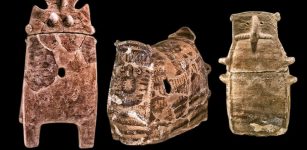 Blue Eyed People In Northern Israel 6,500 Years Ago: New DNA Results
Archaeology | Aug 22, 2018
Blue Eyed People In Northern Israel 6,500 Years Ago: New DNA Results
Archaeology | Aug 22, 2018




